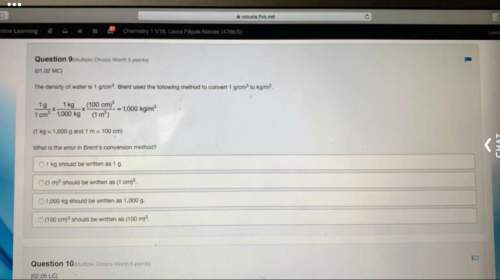1. If you have 6.00 x 10^24 molecules of oxygen how many moles of water would you
have?
...

1. If you have 6.00 x 10^24 molecules of oxygen how many moles of water would you
have?
A. 36.00 moles of oxygen
B. 09.96 moles of oxygen
C. 12.02 moles of oxygen
D. 1.02 moles of oxygen
2. How many atoms can be found in 3.4 moles of Iron (Fe)?
A. 2.047 x 10^24 atoms of Iron
B. 5.65 x 10^24 atoms of Iron
C. 1.77 x 10^23 atoms of Iron
D. 3.5 atoms of Iron
3. If you have 4.27 x 10^24 atoms of Carbon, how many moles of Carbon do you have?
A. 2.84 x 10^48 moles of Carbon
B. 4.12 x 10^24 moles of carbon
C. 4.72 x 10^24 moles of carbon
D. 7.84 moles of carbon

Answers: 3


Another question on Chemistry

Chemistry, 22.06.2019 09:50
What are four significant sources of ghgs that come from wostem washington?
Answers: 2

Chemistry, 22.06.2019 14:30
What is the relationship between wind and ocean waves? question 17 options: wind moving at higher speeds will transfer more energy to the water, resulting in stronger waves. wind moving at higher speeds will transfer energy over a larger part of the ocean water, resulting in waves with a shorter wavelength. winds moving at higher speeds with cause water to move forward at faster rates, causing larger ocean waves. winds moving at higher speeds will affect deeper water, resulting in waves that move at a faster rate. how do temperature and salinity affect deepwater currents? question 15 options: as temperatures and salinity levels of water increase, the water rises to the surface where it creates currents as it moves to colder regions. they create changes in wind direction, moving denser water in the same direction as the wind and causing the deepwater circulation patterns found in the ocean. they equalize the forces on undersea currents caused by the coriolis effect as they replace more dense water with less dense water. they create density differences that cause dense deepwater currents to flow toward the equator where they displace less dense, warmer water above them.
Answers: 2

Chemistry, 23.06.2019 00:30
The footprints of a dinosaur and the burrow of an ancient shrimp are examples of which kind of fossils
Answers: 2

Chemistry, 23.06.2019 03:30
Scientists often deal with numbers that are either very large or very small. for example, the radius of the sun is approximately 696,000 kilometers, while bacterial cells are as small as 1.9 × 10-4 millimeters. express each of these numbers in an alternate form.
Answers: 3
You know the right answer?
Questions

Social Studies, 14.10.2021 22:40




Mathematics, 14.10.2021 22:40


Mathematics, 14.10.2021 22:40



Mathematics, 14.10.2021 22:40

Mathematics, 14.10.2021 22:40



Biology, 14.10.2021 22:40



Spanish, 14.10.2021 22:40

Mathematics, 14.10.2021 22:40

Mathematics, 14.10.2021 22:40

Mathematics, 14.10.2021 22:40




